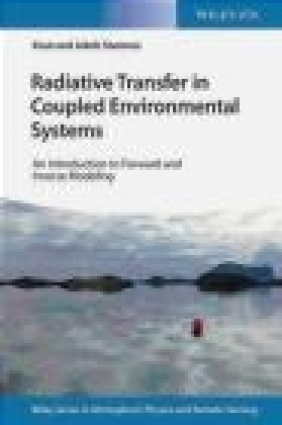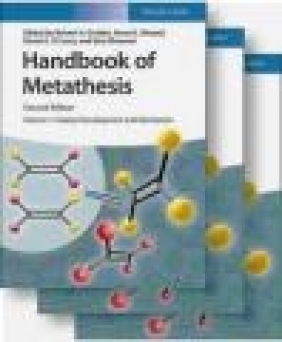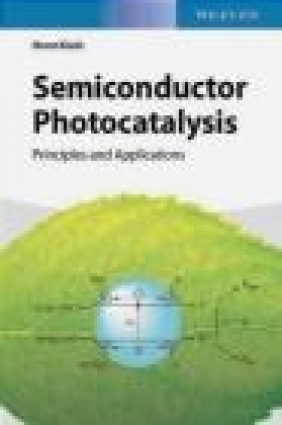Radiative Transfer in Coupled Environmental Systems
Jakob Stamnes, Knut Stamnes
Radiative Transfer in Coupled Environmental Systems
Jakob Stamnes, Knut Stamnes
- Producent: VCH
- Rok produkcji: 2015
- ISBN: 9783527411382
- Ilość stron: 368
- Oprawa: Twarda
Niedostępna
Opis: Radiative Transfer in Coupled Environmental Systems - Jakob Stamnes, Knut Stamnes
This book is dedicated to the formulation and solution of forward and inverse problems related to coupled media, and provides examples of how to solve concrete problems in environmental remote sensing of coupled atmosphere-surface systems. The authors discuss radiative transfer in coupled media such as the atmosphere-ocean system with Lambertian as well non-Lambertian reflecting surfaces at the lower boundary. The spectral range from the ultraviolet to the microwave region of the electromagnetic spectrum is considered, as are multi-spectral as well as hyperspectral remote sensing, while solutions of the forward problem for unpolarized and polarized radiation are discussed in detail.Preface XI Acknowledgments XIII 1 Introduction 1 1.1 Brief History 1 1.2 What is Meant by a Coupled System? 2 1.3 Scope 3 1.4 Limitations of Scope 4 2 Inherent Optical Properties (IOPs) 7 2.1 General Definitions 7 2.1.1 Absorption Coefficient and Volume Scattering Function 7 2.1.2 Scattering Phase Function 8 2.2 Examples of Scattering Phase Functions 11 2.2.1 Rayleigh Scattering Phase Function 11 2.2.2 Henyey Greenstein Scattering Phase Function 11 2.2.3 Fournier Forand Scattering Phase Function 13 2.2.4 The Petzold Scattering Phase Function 14 2.3 Scattering Phase Matrix 14 2.3.1 Stokes Vector Representation S = [I,Q,U,V]T 16 2.3.2 Stokes Vector Representation = [I||, I ,U,V]T 20 2.3.3 Generalized Spherical Functions 22 2.4 IOPs of a Polydispersion of Particles Integration over the Size Distribution 24 2.4.1 IOPs for a Mixture of Different Particle Types 25 2.4.2 Treatment of Strongly Forward-Peaked Scattering 26 2.4.3 Particle Size Distributions (PSDs) 28 2.5 Scattering of an ElectromagneticWave by Particles 29 2.5.1 Summary of Electromagnetic Scattering 30 2.5.2 Amplitude Scattering Matrix 31 2.5.3 Scattering Matrix 32 2.5.4 Extinction, Scattering, and Absorption 34 2.6 Absorption and Scattering by Spherical Particles Mie Lorenz Theory 35 2.7 Atmosphere IOPs 41 2.7.1 Vertical Structure 41 2.7.2 Gases in the Earth s Atmosphere 42 2.7.3 Molecular IOPs 43 2.7.4 IOPs of Suspended Particles in the Atmosphere 45 2.7.5 Aerosol IOPs 45 2.7.6 Cloud IOPs 47 2.8 Snow and Ice IOPs 48 2.8.1 General Approach 48 2.8.2 Extension of Particle IOP Parameterization to Longer Wavelengths 50 2.8.3 Impurities, Air Bubbles, Brine Pockets, and Snow 51 2.9 Water IOPs 53 2.9.1 Absorption and Scattering by PureWater 53 2.9.2 Absorption and Scattering byWater Impurities 54 2.9.3 Bio-OpticalModel Based on the Particle Size Distribution (PSD) 56 2.10 Fresnel Reflectance and Transmittance at a Plane Interface Between Two Coupled Media 63 2.10.1 Stokes Vector of Reflected Radiation 65 2.10.2 Total Reflection 65 2.10.3 Stokes Vector of Transmitted Radiation 67 2.11 Surface Roughness Treatment 68 2.11.1 Basic Definitions 68 2.11.2 Reciprocity Relation and Kirchhoff s Law 70 2.11.3 Specular Versus Lambertian and Non-Lambertian Reflection at the Lower Boundary 71 2.11.4 Scattering, Emission, and Transmission by a Random Rough Surface Kirchhoff Approximation 72 2.11.4.1 Rough Dielectric Interface 72 2.11.5 Slope Statistics for aWind-RoughenedWater Surface 76 2.12 Land Surfaces 77 2.12.1 Unpolarized Light 78 2.12.2 Polarized Light 82 3 Basic Radiative Transfer Theory 85 3.1 Derivation of the Radiative Transfer Equation (RTE) 85 3.1.1 RTE for Unpolarized Radiation 85 3.1.2 RTE for Polarized Radiation 87 3.2 Radiative Transfer of Unpolarized Radiation in Coupled Systems 88 3.2.1 Isolation of Azimuth Dependence 89 3.3 Radiative Transfer of Polarized Radiation in Coupled Systems 90 3.3.1 Isolation of Azimuth Dependence 91 3.4 Methods of Solution of the RTE 93 3.4.1 Formal Solutions 94 3.4.2 Single-Scattering Approximation 96 3.4.3 Successive Order of Scattering (SOS) Method 100 3.4.4 Discrete-Ordinate Method 102 3.4.5 Doubling-Adding and Matrix OperatorMethods 105 3.4.6 Monte Carlo Method 109 3.5 Calculation ofWeighting Functions Jacobians 110 3.5.1 Linearized Radiative Transfer 110 3.5.2 Neural Network Forward Models 112 4 Forward Radiative Transfer Modeling 117 4.1 Quadrature Rule The Double-Gauss Method 117 4.2 Discrete Ordinate Equations Compact Matrix Formulation 120 4.2.1 Cosine Solutions 120 4.2.2 Sine Solutions 122 4.3 Discrete-Ordinate Solutions 123 4.3.1 Homogeneous Solution 123 4.3.2 Vertically Inhomogeneous Media 128 4.3.3 Particular Solution Upper Slab 129 4.3.4 Particular Solution Lower Slab 133 4.3.5 General Solution 134 4.3.6 Boundary Conditions 135 5 The Inverse Problem 137 5.1 Probability and Rules for Consistent Reasoning 137 5.2 Parameter Estimation 140 5.2.1 Optimal Estimation, Error Bars and Confidence Intervals 140 5.2.2 Problems with More Than One Unknown Parameter 147 5.2.3 Approximations: Maximum Likelihood and Least Squares 157 5.2.4 Error Propagation: Changing Variables 160 5.3 Model Selection or Hypothesis Testing 163 5.4 Assigning Probabilities 168 5.4.1 Ignorance: Indifference, and Transformation Groups 168 5.4.2 Testable Information:The Principle of Maximum Entropy 173 5.5 Generic Formulation of the Inverse Problem 181 5.6 Linear Inverse Problems 182 5.6.1 Linear Problems without Measurement Errors 183 5.6.2 Linear Problems with Measurement Errors 185 5.7 Bayesian Approach to the Inverse Problem 186 5.7.1 Optimal Solution for Linear Problems 189 5.8 Ill Posedness or Ill Conditioning 191 5.8.1 SVD Solutions and Resolution Kernels 192 5.8.2 Twomey Tikhonov Regularization TT-Reg 197 5.8.3 Implementation of the Twomey Tikhonov Regularization 198 5.9 Nonlinear Inverse Problems 200 5.9.1 Gauss Newton Solution of the Nonlinear Inverse Problem 201 5.9.2 Levenberg Marquardt Method 203 6 Applications 205 6.1 Principal Component (PC) Analysis 205 6.1.1 Application to the O2 A Band 206 6.2 Simultaneous Retrieval of Total Ozone Column (TOC) Amount and Cloud Effects 207 6.2.1 NILU-UV Versus OMI 209 6.2.2 Atmospheric Radiative Transfer Model 210 6.2.3 LUT Methodology 210 6.2.4 Radial Basis Function Neural Network Methodology 210 6.2.5 Training of the RBF-NN 211 6.2.6 COD and TOC Values Inferred by the LUT and RBF-NN Methods 211 6.2.7 TOC Inferred from NILU-UV (RBF-NN and LUT) and OMI 213 6.2.8 Summary 214 6.3 Coupled Atmosphere Snow Ice Systems 215 6.3.1 Retrieval of Snow/Ice Parameters from Satellite Data 216 6.3.2 Cloud Mask and Surface Classification 218 6.3.2.1 Snow Sea Ice Cover and Surface Temperature 218 6.3.3 Snow Impurity Concentration and Grain Size 219 6.4 Coupled Atmosphere Water Systems 225 6.4.1 Comparisons of C-DISORT and C-MC Results 226 6.4.2 Impact of Surface Roughness on Remotely Sensed Radiances 226 6.4.3 The Directly Transmitted Radiance (DTR) Approach 228 6.4.4 The Multiply Scattered Radiance (MSR) Approach 229 6.4.5 Comparison of DTR and MSR 230 6.5 Simultaneous Retrieval of Aerosol and Aquatic Parameters 232 6.5.1 Atmospheric IOPs 233 6.5.2 Aquatic IOPs 234 6.5.3 Inverse Modeling 235 6.6 Polarized RT in a Coupled Atmosphere Ocean System 237 6.6.1 C-VDISORT and C-PMC Versus Benchmark Aerosol Layer Reflection 239 6.6.2 C-VDISORT and C-PMC Versus Benchmark Aerosol Layer Transmission 239 6.6.3 C-VDISORT and C-PMC Versus Benchmark Cloud Layer Reflection 242 6.6.4 C-VDISORT and C-PMC Versus Benchmark Cloud Layer Transmission 242 6.6.5 C-VDISORT Versus C-PMC Aerosol Particles Coupled Case 245 6.6.6 C-VDISORT Versus C-PMC Aerosol/Cloud Particles Coupled Case 245 6.6.7 Summary 249 6.7 What if MODIS Could Measure Polarization? 249 6.7.1 Motivation 249 6.7.2 Goals of the Study 250 6.7.3 Study Design 250 6.7.4 Forward Model 252 6.7.5 Optimal estimation/Inverse model 252 6.7.6 Results 254 6.7.7 Concluding Remarks 260 A Scattering of ElectromagneticWaves 263 A.1 Absorption and Scattering by a Particle of Arbitrary Shape 264 A.1.1 General Formulation 264 A.1.2 Amplitude Scattering Matrix 265 A.1.3 Scattering Matrix 266 A.1.4 Extinction, Scattering, and Absorption 268 A.2 Absorption and Scattering by a Sphere MieTheory 271 A.2.1 Solutions of VectorWave Equations in Spherical Polar Coordinates 272 A.2.2 Expansion of Incident PlaneWave in Vector Spherical Harmonics 275 A.2.3 Internal and Scattered Fields 277 B Spectral Sampling Strategies 287 B.1 The MODTRAN Band Model 289 B.2 The k-Distribution Method 290 B.3 Spectral Mapping Methods 293 B.4 Principal Component (PC) Analysis 294 B.5 Optimal Spectral Sampling 294 C Rough Surface Scattering and Transmission 297 C.1 Scattering and Emission by Random Rough Surfaces 297 C.1.1 Tangent Plane Approximation 298 C.1.2 Geometrical Optics Solution 300 C.1.2.1 Stationary-Phase Method 301 D Boundary Conditions 313 D.1 The Combined Boundary Condition System 313 D.2 Top of Upper Slab 315 D.3 Layer Interface Conditions in the Upper Slab 317 D.3.1 Interface Between the Two Slabs (Atmosphere Water System) 319 D.4 Layer Interface Conditions in the Lower Slab 325 D.5 Bottom Boundary of Lower Slab 325 D.5.1 BottomThermal Emission Term 327 D.5.2 Direct Beam Term 327 D.5.3 Bottom Diffuse Radiation 328 D.5.4 Bottom Boundary Condition 329 References 331 Index 347
Szczegóły: Radiative Transfer in Coupled Environmental Systems - Jakob Stamnes, Knut Stamnes
Tytuł: Radiative Transfer in Coupled Environmental Systems
Autor: Jakob Stamnes, Knut Stamnes
Producent: VCH
ISBN: 9783527411382
Rok produkcji: 2015
Ilość stron: 368
Oprawa: Twarda
Waga: 0.94 kg






























